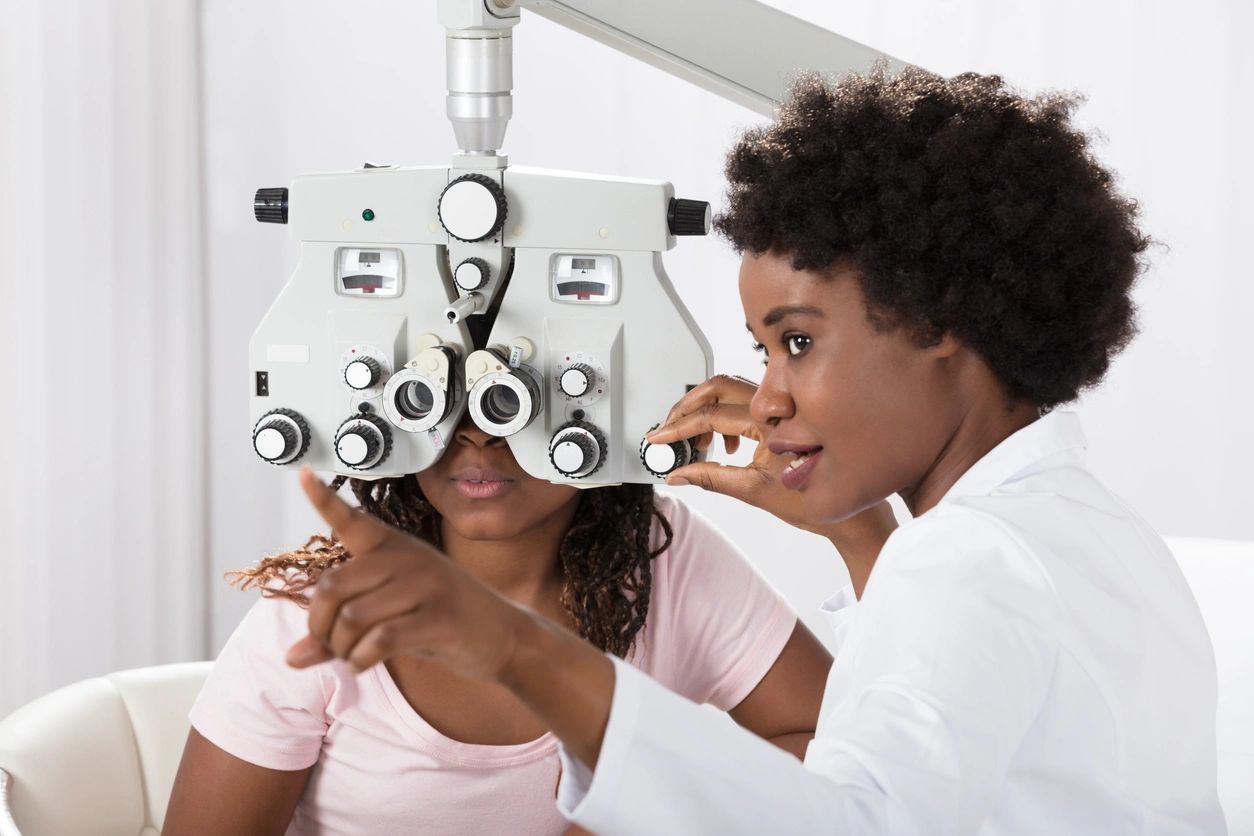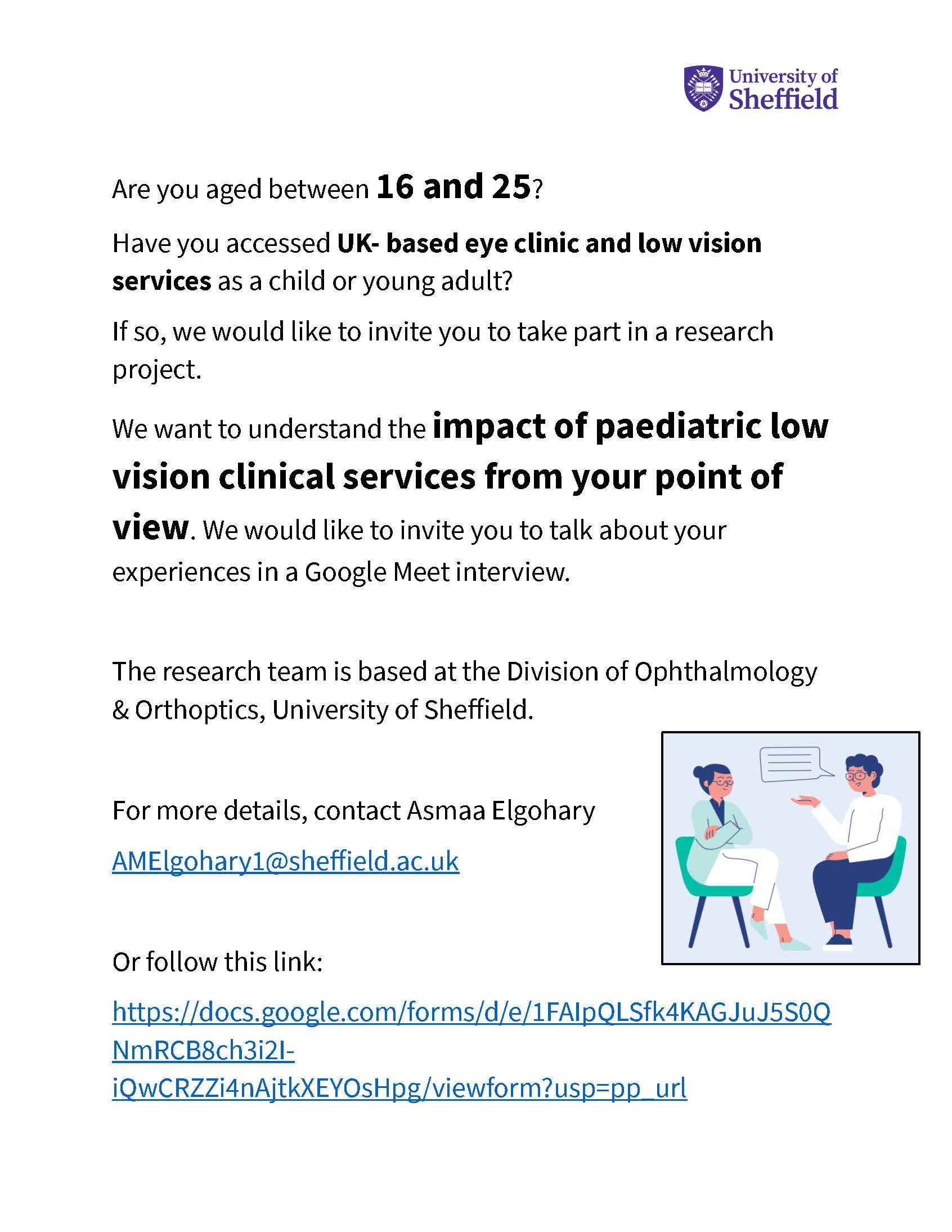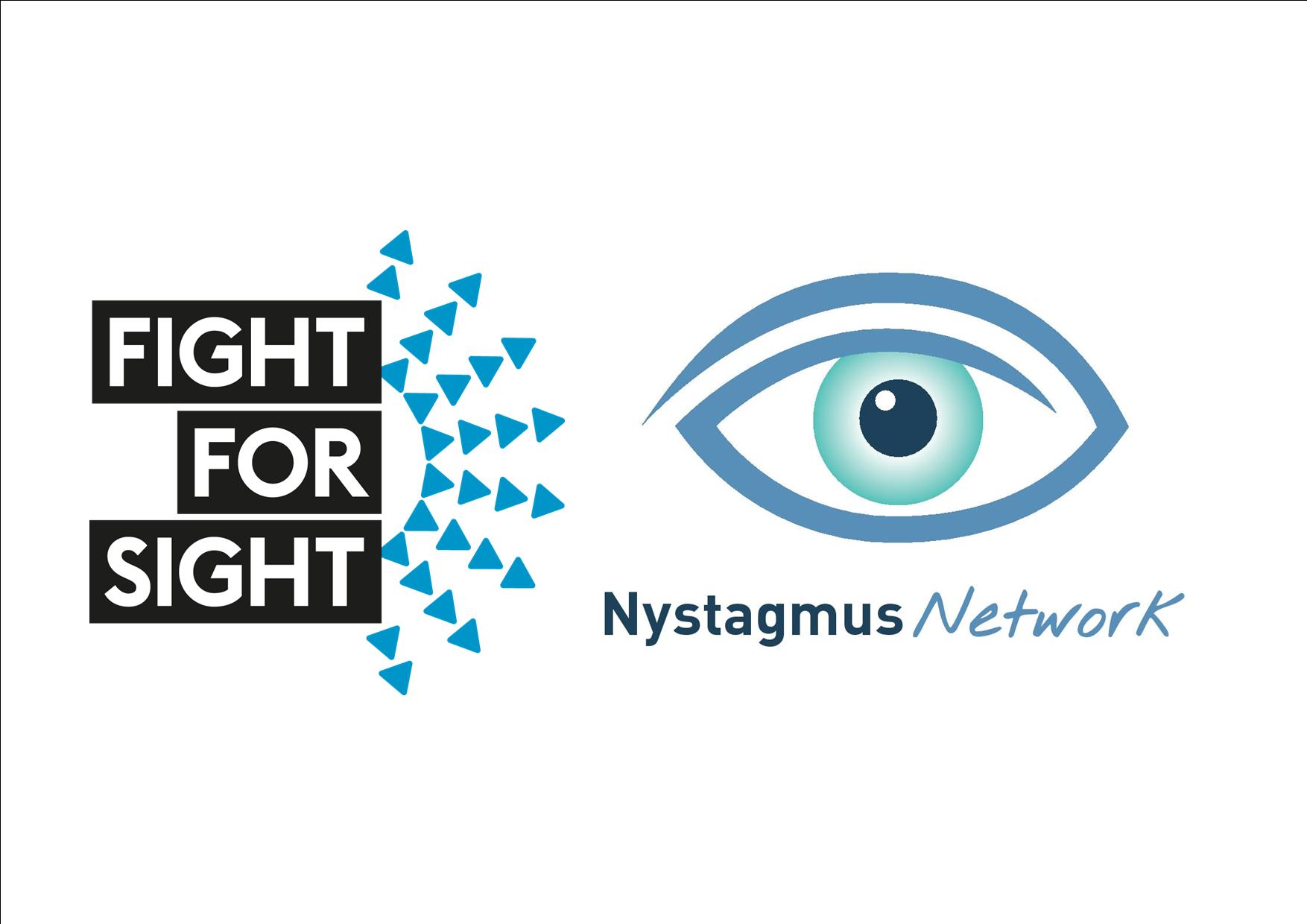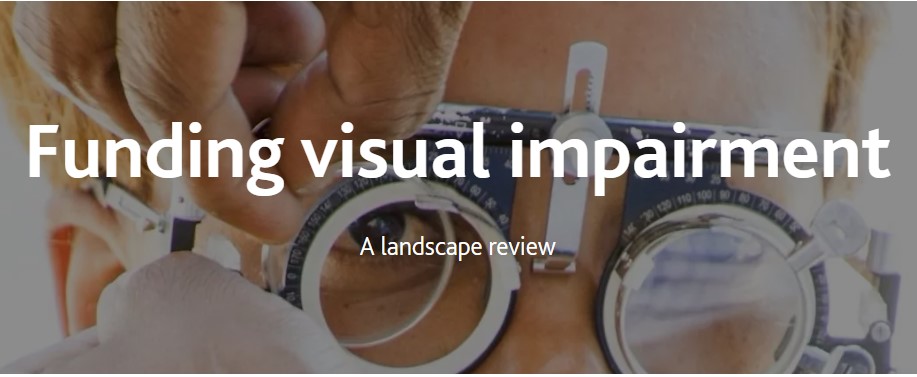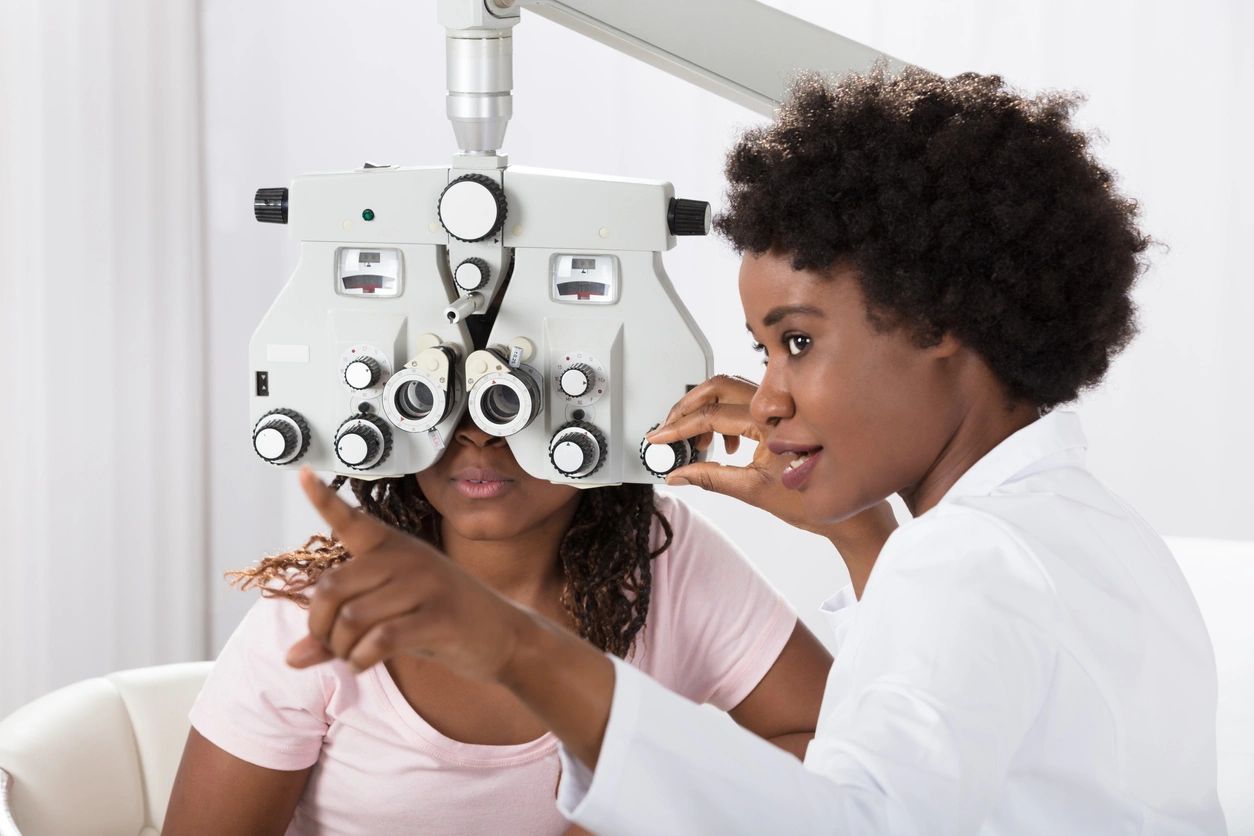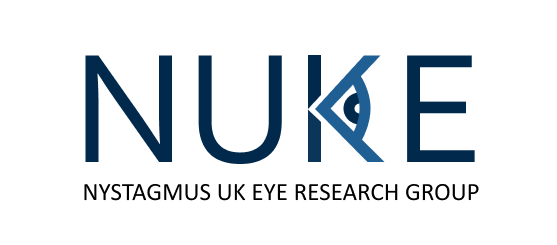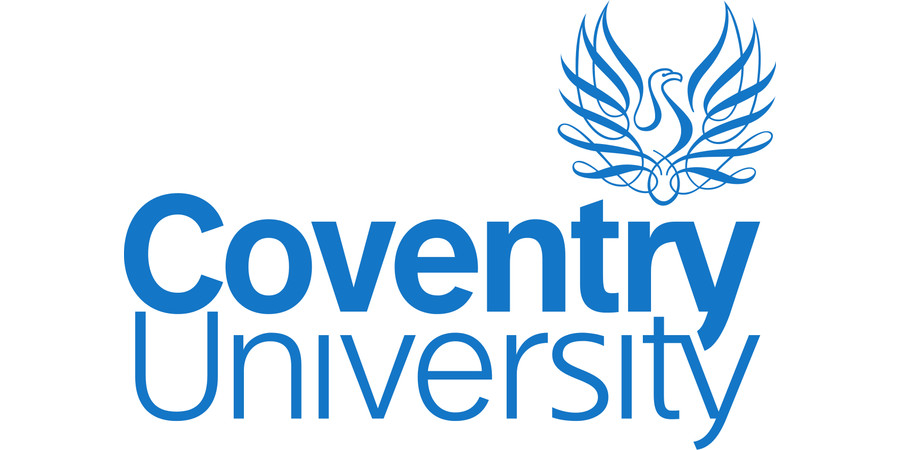Research participation opportunity
Developing university guidance for the socio-emotional needs of students with vision impairment
PARTICIPANT INFORMATION
You are invited to take part in a research project conducted by the Institute for Mental Health, the University of Birmingham. This research work is led by Dr Ifigeneia Manitsa, Research Fellow in Youth Mental Health.
Before you decide, it is important for you to understand why the research is being done and what it will involve. This Information Sheet will tell you about the purpose of the research, along with its potential risks and benefits.
If you agree to take part, we will ask you to sign a Consent Form. If there is anything that you are not clear about, we will be happy to explain it to you. Please take as much time as you need to read it. You should only consent to participate in this research study when you feel that you understand what is being asked of you, and you have had enough time to think about your decision.
It is up to you to decide whether or not to take part. If you decide to take part, you are still free to withdraw at any time during your participation in this study and without giving a reason. If you have any further questions, please contact Dr Ifigeneia Manitsa at [email protected]. If you have any medical/other problems which make it difficult for you to read this information, please contact Ifigeneia for a verbal explanation of the research. If you choose not to take part at all or decide to withdraw your data, you will not be paid for your participation.
When you are happy that you have all the information you need to be able to decide whether or not you would like to take part in the study, please complete the enclosed consent form and return it to Dr Ifigeneia Manitsa at [email protected].
Current Study
The Institute for Mental Health at the University of Birmingham in collaboration with the Vision Impairment Centre for Teaching and Research (VICTAR), Kingston University, University of Edinburgh, Abertay University and Bristol Sensory Support Service are conducting research to understand more about the university experiences of individuals with vision impairment who are currently enrolled and pursuing a university degree (undergrad, masters, and doctoral students) and/or have recently (within the last five years) completed a university degree in the UK. This research project is also looking at the experiences of professionals from national organisations (e.g., consultants and habilitation officers) and university staff (e.g., academics and disability officers) supporting students with vision impairment in Higher Education. This project is funded by the Thomas Pocklington Trust Grants Programme.
What do I have to do?
This study will consist of two phases. First, we would like you to complete a short demographic questionnaire and participate in an online interview with us via Microsoft Teams in September/October 2023 (Phase 1). The online interview will last approximately one hour, and you will be asked to talk about your experiences in Higher Education and what type of support you are receiving (or received) during your university degree. We would also like to hear your ideas and suggestions for how universities might better support students with vision impairment in the future. Then, our research team will need some time to analyse the data that we will collect during Phase 1.
In Phase 2 that will run from February to April 2024, we would like to conduct three online 60-minute sessions with 4-6 students with vision impairment. Researchers will ask some questions and you will be able to share your thoughts and experiences about the support you receive with others in these online sessions. You will also be asked to discuss the findings of Phase 1 and discuss the socio-emotional support that should be provided to people with vision impairment in Higher Education. In addition, during these online group sessions, the research team may ask you to discuss the mental health and wellbeing guide provided by Thomas Pocklington Trust for students who want to go to university (https://www.pocklington-trust.org.uk/student-support/university/mental-health-and-wellbeing/). The transition guide “Your future, your choice: bridging the gap” developed by RNIB and VICTAR (https://media.rnib.org.uk/documents/Your_Future_Your_Choice_Bridging_the_Gap.pdf) and some of its online resources may also be used and discussed during these online sessions. You may also wish to follow up comments that other people have said and to ask your own questions. You do not have to answer every question, nor should you feel pressurised to talk.
Considering we can only recruit up to 4-6 students with vision impairment for our online group sessions, we will have to give priority to the students who contact us first. Furthermore, you can decide to only participate in Phase 1 if you do not wish to participate in Phase 2.
We will also be conducting focus groups with people with professionals who work in UK universities to support students with vision impairment.
How will the things I say be used?
Overall, this research project aims to explore the lived experiences of students with vision impairment in Higher Education and to identify the lack of holistic and person-centred approaches to the socio-emotional needs of individuals with vision impairment wishing to attend HE in the UK. This project also aims to initiate the development of university guidance that will address their socio-emotional needs and educational inclusion.
After each session, a summary report with the main findings will be sent to you. Descriptions of research findings will be published in newsletters of the professional support groups and educational institutions involved. In addition, we will publish the findings from the study in scientific journals and will present the results at relevant conferences. No names and identifying information will be published in any reports and future publications. A full report will be submitted to the Thomas Pocklington Trust who may wish to upload it on their website. All of your personally identifiable information will remain anonymous and confidential.
We will video record the focus groups so that we have an accurate recording of the discussion.
Most participants enjoy taking part in research however if this brings up unwanted feelings and you wish to talk it over potential sources of advice are:
The Samaritans – phone: 116 123; email: [email protected]
Citizens Advice – www.citizensadvice.org.uk
RNIB Helpline – 0303 123 999
Will what I say be anonymous?
In our publications and reports your responses will be anonymised but in rare cases where someone knows you very well others may be able to recognise you. Also, the other participants in the online group sessions will hear your responses. We will remind participants that what is said during these sessions must not be discussed outside these online group sessions; however, this relies on everybody sticking to this rule. Further, if you choose to use your camera during the teams call, you may be visually identifiable. You can choose not to turn on your camera if you prefer.
If, during the course of the interview, you inform us that you or someone you know is at serious risk of harm, we will take the appropriate advice and act accordingly.
What should I do if I change my mind?
During the course of the online group session, you can leave at any time by clicking on the ‘leave meeting’ button. Your data will not be included in the research.
If after taking part in an online interview and/online group session you decide that you no longer wish to take part in the project, please email the project lead Ifigeneia Manitsa ([email protected]) and we will remove and permanently delete your data. You must do this within one week of taking part in both tasks (online interview and online group session) otherwise we will not be able to remove your data as we will have begun to analyse it.
Where will data be stored?
The data collected will be kept in locked or password protected storage at the University of Birmingham or held on a password protected database. All information gathered about you will be stored separately from any information that would allow someone to identify who you are (this is known as personal identifying information, e.g., your full names, your address, your contact details). Your personal identifying information will be stored on a local password-protected server and only members of our research team will have access to it. We will only be able to trace the information we have collected about you back to you using a special reference number which we will store in a password protected database held at the University of Birmingham. Only members of our research team will have access to that database. Personal identifying information will be treated as strictly confidential and handled in accordance with the provisions of the Data Protection Act 2018 and the General Data Protection Regulation (GDPR) 2018.
Do I get anything for taking part?
In Phase 1, as a token of appreciation for your time you will receive a £20 payment.
In Phase 2, you will receive a £20 payment after each online group session (three payments in total).
If you need a carer present during the interviews to support you, then an additional payment of £10 will be offered to your carer for assisting you during the interview process.
What will happen to the data afterwards?
The information that you provide will be stored on a local password-protected server and only members of the research team will have access to it. All personal details will be kept separately from the information collected. Participants will be identified by a unique number so that it will only be possible to connect results to individuals via this number. This will ensure that results are kept anonymous.
At the end of the study, your personal details will be destroyed unless you tell us otherwise. This means that we would no longer be able to trace the results of your assessments back to you. It is optional for you to be contacted by the same research team for future ethically approved research of similar nature. If you agree, the research team will contact you according to your preference via phone or email. If you agree to be contacted for future studies, you do not give consent to future studies. This option does not impact on the participation of this study or any future study. This database is password protected and only approved members of our research team have access to your details. We do not share your details with anyone outside the research team.
What happens if I decide that I no longer want my details on the database?
All you would need to do is contact Ifigeneia, the Principal Investigator of the study, at [email protected]. Your details will be removed from the database immediately.
Consent
After having read all the information and having received appropriate responses to any questions that you may have about the study you will be asked to give your consent to participate in the study if you decide that you do wish to participate. We need to receive consent from you in order for you to participate.
Withdrawal
You are free to withdraw from the study within 7 days from taking part in the one-to-one interview (Phase 1) and each online group session (Phase 2). Should you choose to withdraw from Phase 1, you can also request that any data collected from your participation be withdrawn from the study. If you request this, any data collected from you will be located and destroyed. However, once each online group discussion is complete (Phase 2), we will be unable to destroy any of your data. However, we will exclude them from the analysis. Even if you decide to withdraw from the study, you will still receive your compensation.
What if there is a problem?
If you have a concern about any aspect of this study, you should ask to speak to the researchers who will do their best to answer your questions. Please contact the Principal Investigator Ifigeneia Manitsa at [email protected] in the first instance. If you remain unhappy and wish to complain formally, you can contact: Professor Ed Wilding; Head of School; School of Psychology, University of Birmingham, Birmingham, B15 2TT, by email: [email protected] or by phone on 0121 414 4931.
Review
The study has been approved by the Science, Technology, Engineering and Mathematics Ethical Committee.
Further information
If you would like any more information about the study, please contact the Principal Investigator Ifigeneia Manitsa at [email protected].
Research team
Principal Investigator: Dr Ifigeneia Manitsa, Research Fellow in Youth Mental Health, Institute for Mental Health, School of Psychology, University of Birmingham, [email protected]
Co-Investigator: Dr Rachel Hewett, Associate Professor, School of Education, University of Birmingham
Co-Investigator: Dr Fiona Barlow-Brown, Associate Professor, Department of Psychology, Kingston University London
Consultant: Professor John Ravenscroft, Moray House School of Education and Sport, IETL, University of Edinburgh
Consultant: Dr Mhairi Thurston, Senior Lecturer, School of Applied Sciences, Abertay University
Consultant: Dr Joao Roe, Head of Sensory Support Service, Bristol City Council


